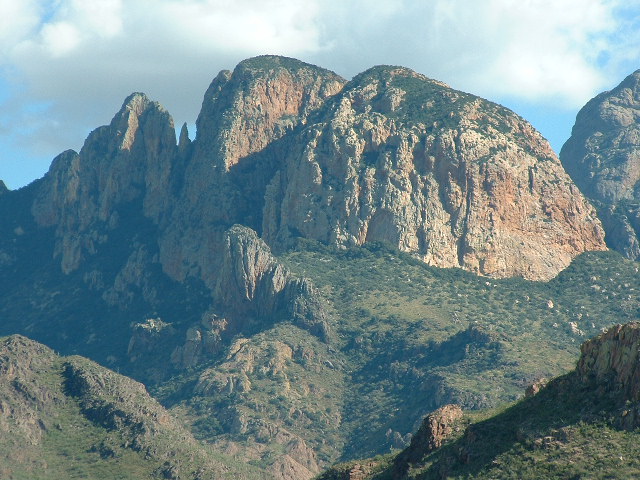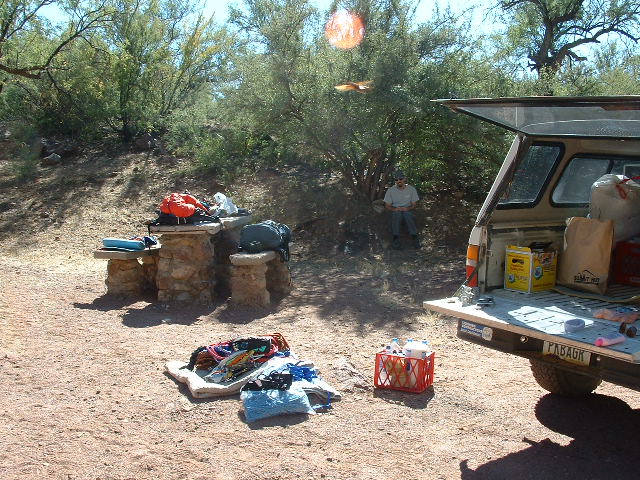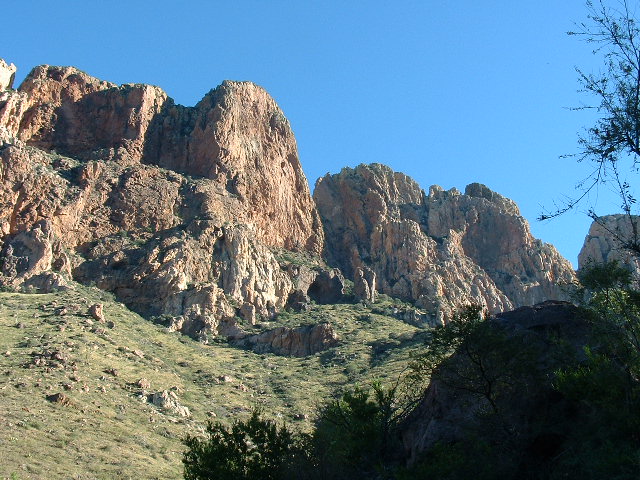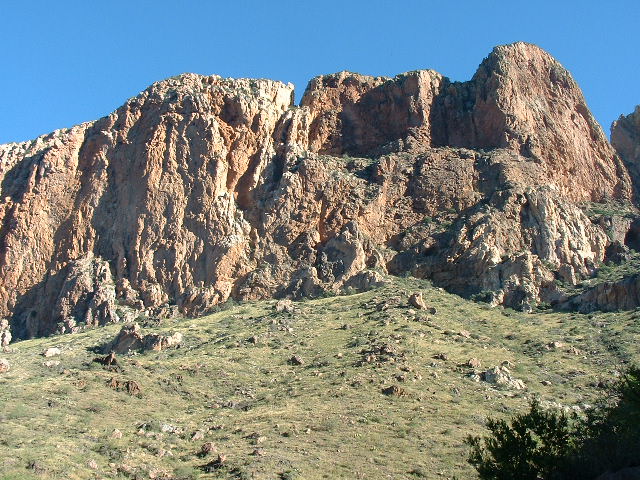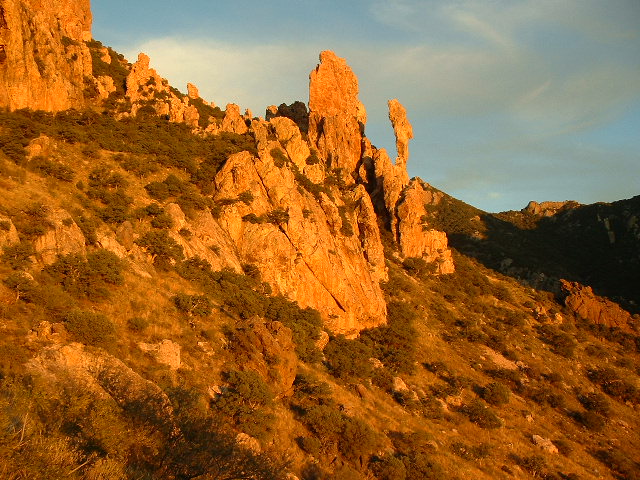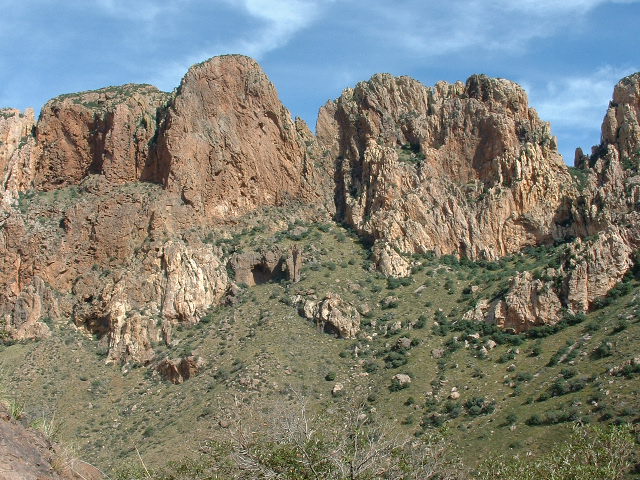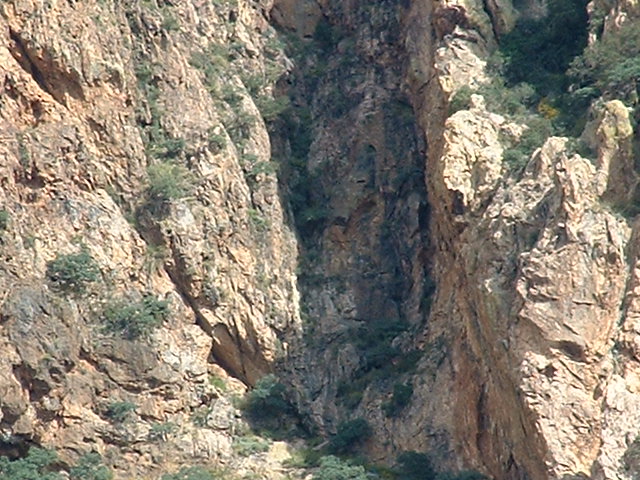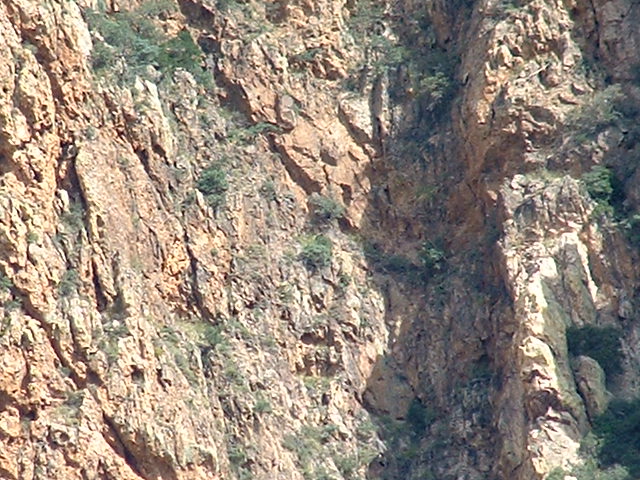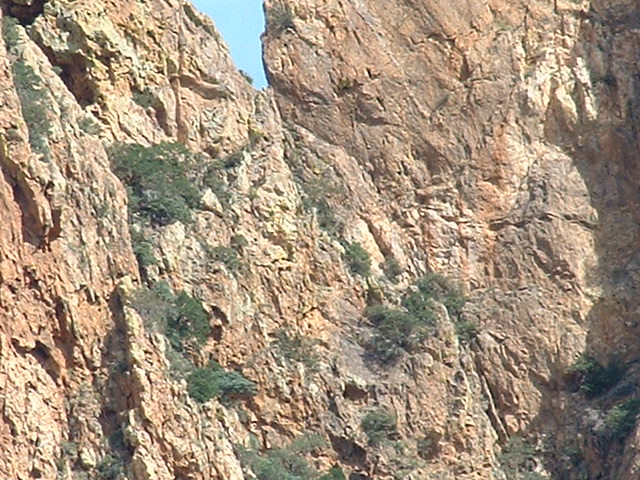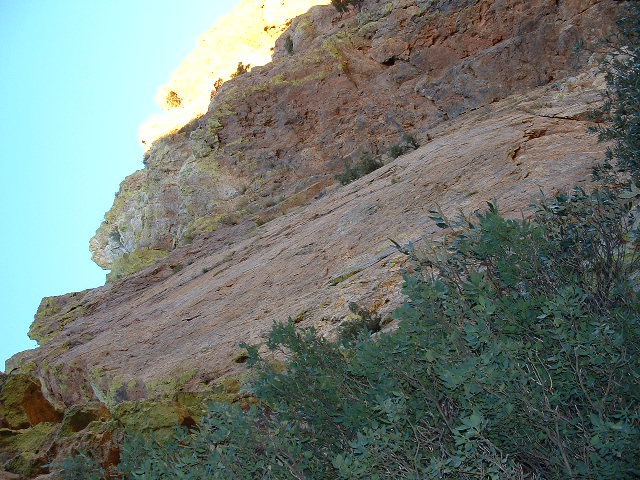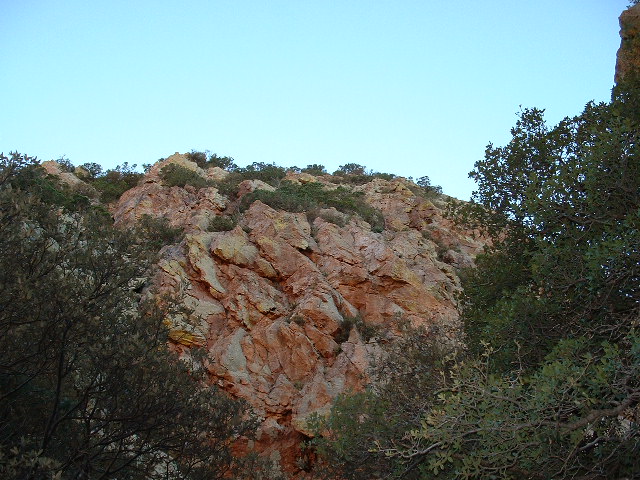For years, I had been whittling away at a list of 400 peaks on an Indian reservation near home. Most of them were pretty straightforward climbs, but there were a few very challenging ones. Some of these were so difficult that I felt strongly that they had not been previously climbed. The main reason I wanted to climb them was that they were on the list, not because they were unclimbed, but the latter reason didn’t hurt any either – it never hurts. Truth be told, it’s one of the greatest rewards of peakbagging.
Anyhow, one of them was a real whopper, a hellacious thing less than two miles from Baboquiviri Peak. Peak 6328 was one of the steepest peaks in Arizona. There are 7,430 peaks in Arizona, and this peak ranks 45th-steepest out of all of them. In fact, the topographic map showed something rather unique – an area just west of the summit where a full 600 vertical feet of contours just plain disappear! A good definition of steepness in the mountaineering world is as follows: steepness is the average of the angles in all directions downward from the summit at a fixed distance of 100 meters. The picture below shows some important details. The two huge rounded masses in the sunlight make up Peak 6328, as seen from the northwest. To the left of it, in the deep gash, is what we will call “the blade”. And to the left of that, mostly shaded, is the steep crag called Peak 6300.
Well, 6328 was on my list. I had looked at it from every side, for years, and now that it was a must-do peak on a list, I needed to figure out how to get to the top of it. Truth be told, I guess I was becoming obsessed with climbing it. It certainly was way beyond my capabilities – I needed to find a skilled technical climber to lead me up it. Not simply a climber who could climb at a high level, but also someone who would not balk at the nasty stuff an adventure climb in the desert could throw at him. I knew a guy who had all the qualifications, an old climbing partner from Canada. Brian Rundle was the perfect guy to lead this. We had climbed together since 1977 on many different mountains, and he was someone I would trust under any circumstances. Once I threw the details at him, he agreed to fly in from Chicago – November 9 would be our starting date. The write-up that follows is Brian’s – from time to time, I have added a comment, which shows up in italics. It was a very exciting climb, and certainly the hardest technical climb I have ever done in my life. Those of you who know me well know that I am not a technical climber, so I was way out of my league here. Here are a few stats on the climb:
Elevation of the peak – 6,328 feet Vertical gain from the vehicle to the start of the rock – 1,825 feet Vertical height of the lower half of the rock face – 400 feet Vertical height of the upper half of the rock face – 550 feet Number of rappels used to descend from the summit – 12 Number of bivis – 2 (one planned, one unplanned)
So, what follows is Brian’s write-up. I am very excited to present it to you here. I hope you enjoy it.
We got a planned late and leisurely start from Tucson, arriving at the trailhead by noon on an early November day. Trailhead itself is a bit of a misnomer. There is a good trail that goes in to a popular climbing destination, but we are only afforded the luxury of following it for an all-too-brief period. After this we must break off and follow indistinct cattle trails and a brushy creek bed up a remote valley.
The creek bed itself is littered with the bleached bones of cattle that died of unknown causes in the wilderness as opposed to the known fate of the abattoir. It’s always an omen in my books to come across skeletal remains of any animal during the approach to a climb. The counter-spell though, was the hundreds of butterflies forming little moving rainbows throughout the brush. We were trying to follow the go-fast, go-light doctrine, but even so it seemed that we had a ton of gear.
Part of the difficulty of desert climbs of course is having adequate water. We were planning to be at least 3 days in, and there would be no water at all up high. The thought of carrying in enough water all the way from the truck was a tough thing to contemplate. We figured that there would be some pools, if not even some running water in portions of the creek in the valley, based on observations Desert Mountaineer (DM) had made in previous months on one of his several valuable recons into the area. Our plan was to bring a filter and to filter water at the last possible moment before heading up from the valley bottom to our bivi site. The plan and our luck panned out, but just barely. There was one small bug- and nematode-infested pool at the last good opportunity to leave the valley. We filtered approximately 10 litres of water. Hopefully enough to hydrate two guys for 3 days.
Fortunately, being November, the blistering conditions of the Arizona summer furnace were well past. One of the other contributing factors to our loads was the uncertainty of the climb. A first ascent of the peak and route undoubtedly was in order, and as such we had no good beta on the quality or type of rock, or difficulties we might encounter. That being the case, we were loaded for bear with a full rack of cams, wires, and hexes. A 60M rope, a 60M static rap cord, and lots and lots of slings rounded out the gear. We had some pins and a hammer but we opted to leave them in the truck, as the packs were already close to the line.
An hour or so later found us lower than we had expected to get and caught in the gathering dusk, but at a tremendous bivi site. There was a wonderful level grassy section on the steep hillside, with a couple of trees. It was several hundred feet lower than where we wanted to be, but, as it turned out, was the best site around. The surrounding area defied description. The entire south face of our peak reared over our heads. There were equally staggering cliffs on the other side of the valley to the south of us. A huge cavern big enough to hold a house looked down on us from the wall looming above and there was a tall, eerily-curved freestanding pinnacle that held watch to the east.
We hastily ate and drank and prepared to settle in for the night as the bats buzzed us in the deepening twilight. And what a night it was. The Milky Way splashed across the heavens in a majestic display until dimmed and finally extinguished by the moon rising during a full lunar eclipse. To top it all off, the evening show was concluded with a meteor shower. Throughout the night, we heard mysterious animal calls coming from the cliffs above and around us, that we were never able to figure out. My vivid imagination was also running overtime as I was picturing mountain rattlesnakes wanting to crawl into my bag for warmth. All of the magnificence of the environment, the primal noises, the fears and the anxiety of the unknown climb awaiting us in the morning contributed to a very fitful, albeit beautiful, night.
We pulled ourselves from our bags with the first glimmer of dawn in the east. A hasty breakfast was eaten as we organized the gear and supplies for the day. The plan was that I would lead all of the pitches and that DM would follow, carrying a summit pack with the rappel gear, and a small amount of food and clothing, and maybe 3 of the 10 essentials. A brief 30-minute uphill section warmed us up and brought us to the chink proper. There is a steep headwall here that heads up from a broad grassy ramp that was the upslope continuation of our bivi site. This headwall leads to a notch between our peak and a slightly lower summit to the east. Also sharing the notch is a leaning pinnacle and the stunning blade-shaped lower ridge of the east peak. We rope up at the base of the headwall and I head off without much ado.
The next picture shows our peak, as seen from the other side of the valley on an earlier exploratory trip. Our route went up the open area in the center, on the rock just to the left of the long vertical shadow.
The meter starts running. This is our first real opportunity to suss out the actual rock. I am not impressed, not one little bit. I make an abortive foray up one section, placing a couple of very questionable pieces of gear. It’s total garbage and I end up down-climbing that bit and traverse off to the left to investigate a line that DM suggests may hold more promise. His suggestion works and our upward progress continues. The rock is rough, but of very poor quality, and mostly lacking cracks or flakes to use for placing pro. There are many shallow pockets, but I don’t have a lot of gear that will work on such features. This section of the route, as with most of the climb, is surprisingly vegetated. Much more so than I was expecting based on the photos we had.
This fact is a mixed blessing as it affords some chances of barely adequate protection, especially at belays, but it also causes major grief as there are constant opportunities for the rope to snag and for our bodies to get impaled on sharp branches and various cacti.
I climb a short first pitch. I am really trying hard to rationalize in my mind why I am here climbing this crap. I am trying to formulize the words to tell myself and DM that this is insane bullshit and that we should back off here and now, before we get into some serious trouble higher up. But somehow the words can’t or won’t crystallize properly by the time I bring DM up to the belay. I think I actually speak the words, but without any real conviction or meaning, because DM hands over the gear and I dumbly cast off on the second pitch. This pitch however turns out to be the best on the entire climb. I am able to run out the full rope length virtually straight up, over mostly brush-free rock with awesome holds. The climbing is not harder than 5.6 but I can only get in 6 or so marginal pieces of pro in 60M. By the end of this pitch I have quelled my distaste and fears somewhat. This was an amazing pitch, dead vertical, brilliantly led by Brian. He ran out the full rope-length, almost 200 feet. I kept calling out to him how much rope he had left, and, by the time he was done, I was belaying him on my tip-toes.
The third pitch is also very long, and has me pulling past numerous small caves in the rock that could house who knows what. Possibly the homes of the mysterious animal voices from last night. The pitch is easy though, and I cruise it, placing only 2 or 3 pieces of pro in its entire length. The next pitch, the fourth, is a short zigzag walking pitch that brings us to the ledges and blocky terrain of the notch. The sharp blade of the east peak’s west ridge soared starkly above us like some kind of prehistoric knife.
The first pitch of the upper ridge is short. Again I have a false start. I get to a section that I don’t think I can climb and I yell this down to DM. He relates later that his heart sank when I said this. This climb is integral to his project and completing it is very important to him. I down-climb a portion and start again to the left, finishing off a short bit later. The rock seems to be different on the upper portion of the climb. Much more granitic in nature. It is actually rather reassuring to climb on. We lose a large portion of time here as the excess rope has contorted itself into a seething mass of tangles that takes a very long time to sort out.
After what seems an eternity, DM gets the mess sorted out and I finish the pitch and belay him up. The next pitch also has a false start, leading me to an overhang that I probably shouldn’t try, so I quickly recover by an elegant stemming move to the left at 5.6 or maybe 5.7. The pitch is long but well-protected, although I lead it like a rookie idiot. I have incurred so much rope drag that it takes all of my effort just to pull myself to the belay. It is torture trying to bring in the rope as I belay DM upward. I am completely shagged out, but I have a feeling that the final summit ridge can’t be too far off. Once more we do a gear handover and I head up. Both the rock and protection are good and the pitch is dispatched in quick order. And even better is that I am only a few meters walk away from the summit. I quickly bring DM up and let him know the good news.
Please stay tuned for the exciting conclusion of this climb. It’s what happens on the way down that is the most dramatic.
To be continued………………………………………
Visit our Facebook page at https://www.facebook.com/pages/Desert-Mountaineer/192730747542690

